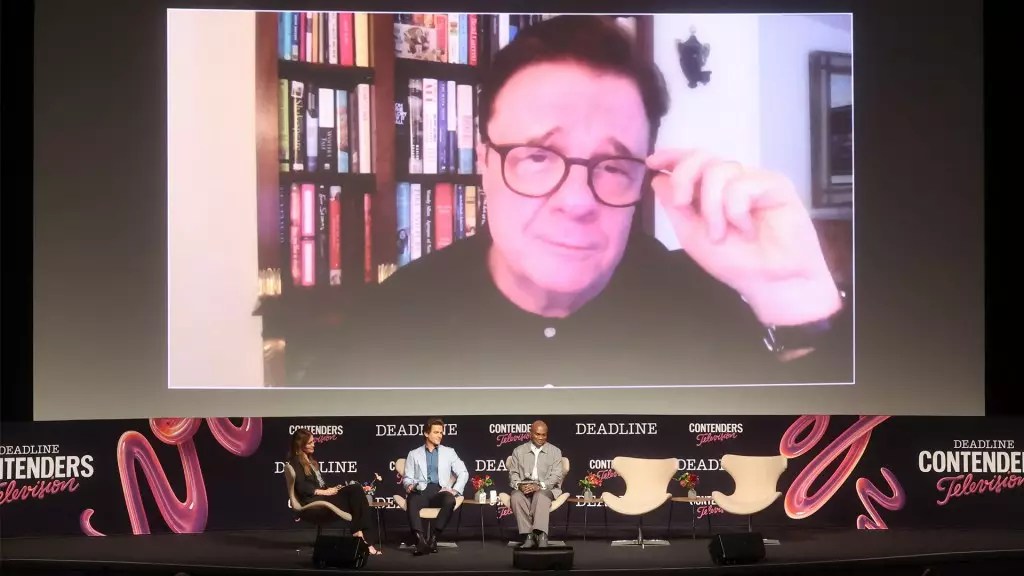In an era where the shadows of oppressive politics loom larger than ever, a television series emerges as a beacon of hope, laughter, and representation. ‘Mid-Century Modern’, featuring luminaries such as Nathan Lane, Matt Bomer, and Nathan Lee Graham, stands out not only for its vibrant characters and humor but for its undeniable timeliness in addressing LGBTQ+ issues. The creators and cast have expressed a profound sense of purpose in presenting this gay-themed sitcom, which they believe serves as a welcome counterbalance to a society that increasingly seems to marginalize their community. Their sentiments echo a collective yearning for a narrative that celebrates gay life rather than vilifies it.
Lane, adept at intertwining humor with poignant social commentary, points out the urgency of such representation during a time when civil liberties are under threat. His remarks during a recent panel reflect a broader acknowledgment within the LGBTQ+ community that visibility remains a crucial battleground. By presenting authentic gay experiences, the series is not just offering entertainment; it’s challenging audiences to confront their biases and expand their understanding of queer identities. This is not merely about entertainment—it’s a rallying cry for empathy and acceptance in an increasingly intolerant world.
A Found Family and Relatable Joy
The premise of ‘Mid-Century Modern’ revolves around the dynamic lives of three older gay men who forge a new path together after loss, revealing both levity and depth in their shared experiences. Set in the sun-soaked atmosphere of Palm Springs, the show artfully navigates themes of friendship, aging, and resilience through humor and heart. Lane’s character, Bunny, is described as a bra chain magnate, alongside the effervescent Jerry (Bomer) and the more somber Arthur (Graham). This trio encapsulates the essence of a “found family,” a concept that resonates deeply within the LGBTQ+ community, where traditional family structures may often feel distant or unwelcoming.
The interactions between these characters inject the series with a blend of witty repartee and emotionally charged moments. Each on-screen encounter invites viewers into an intimate portrayal of companionship marked by joy, conflict, and ultimately, personal growth. Graham poignantly expresses the liberating nature of playing a character free from shame, contributing to the genuine portrayal that underlines the show’s narrative strength. The gravity of these relationships, juxtaposed against the backdrop of humor, creates a rich tapestry that many viewers can find solace in.
A Tribute to Grail and Grace
Adding depth to the show’s journey is the poignant tribute to Linda Lavin, who passed away during production. Her character’s storyline affords the series both a reflective quality and an intrinsic emotional weight. Episode 9, aptly titled “Here’s to You, Mrs. Schneiderman,” focuses on the impact of loss within this tightly-knit group. The loss of Lavin—a seasoned actress whose contributions to theater are immeasurable—leaves a legacy of grace and strength that permeates the series. Both Bomer and Lane have underscored the influence Lavin had on the cast, fusing their professionalism with a warmer, familial bond. This personal connection enhances the narrative, fostering a raw authenticity that stands out among contemporary sitcoms.
The creators, Ryan Murphy, Max Mutchnick, and David Kohan, have channeled this collective grief into a narrative that both honors Lavin and propels the stories forward. Instead of sidelining the conversation surrounding loss, ‘Mid-Century Modern’ integrates it as a vital part of the emotional landscape, allowing the ensemble to navigate the spectrum of human experience fully.
The Sound of Genuine Laughter
In a world often filled with artificial sounds and forced laughter, ‘Mid-Century Modern’ takes a refreshing approach by integrating real audience reactions, which enhances the viewing experience. Graham’s gentle defense against accusations of relying on a laugh track reveals a commitment to authenticity that resonates within the fabric of the show. An audience that genuinely engages fosters an atmosphere of unrestrained joy, presenting the sitcom format as a platform for tangible connection—both onscreen and off.
This commitment transforms standard comedic tropes into uplifting moments, allowing ‘Mid-Century Modern’ to transcend the confines of traditional sitcoms. By weaving relevant societal issues into its narrative while simultaneously celebrating the mundane joys of life, the series challenges viewers to find humor and happiness amid adversity. In doing so, it not only entertains but also empowers, inviting audiences from all walks of life to join in the laughter and understanding.


Leave a Reply